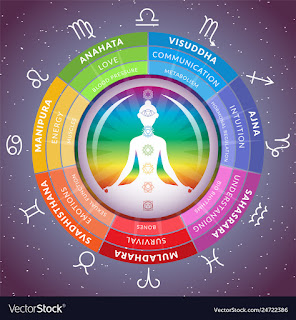March 26, 2020
Next Time You Fly, Please Don't Do These Things...
Flying is supposed to be a fairly luxury experience (yes, even if you're flying economy).
However, even the sky is not spared from the horrors of unruly and utterly inconsiderate fellow travellers.
1. If there is a vacant seat in the row front of you, please don't prop up your feet up on the arm rests.
2. Don't clip your toenails
3. Never ever toss a coin into a plane's engine
4. Don't have sex
5 Don't watch porn
6. Don't take off your clothes
March 16, 2020
Chakra Meditation: How to Balance Your 7 Chakras
Chakra is a Sanskrit word for ‘wheel’. There are a total of seven chakras. They run down the midline of the body, from the very base of the spine to the top of the head.
Each chakra acts as a gatekeeper for its respective area, as the energy travels through us. When they are working smoothly, our vitality and energy can flow easily to where it’s needed the most.
1. Root Chakra (Muladhara) root-chakra-1.jpg
Color: Red
Mantra: LAM
This chakra is found at the base of your spine. It governs your connection to the wider world, your fundamental needs for food, shelter, and stability. Issues with your root chakra can cause a number of emotional and physical disturbances, especially digestive ailments.
2. Sacral Chakra (Svadhisthana)
Color: Orange
Mantra: VAM
The sacral chakra rests just below the navel. It’s intimately involved in the creative process; it governs both your reproductive organs and your imagination. A balanced sacral chakra is essential for coping with new experiences and
3. Solar Plexus Chakra (Manipura)
Color: Yellow
Mantra: RAM
Your solar plexus chakra sits above your navel, in your stomach. This chakra is fundamental to digestion, but it also has an important mental and spiritual role. You can only embrace the things you experience and understand your place in them when your solar plexus chakra is in balance.
4. Heart Chakra (Anahata)
Color: Green
Mantra: YAM
On a physical level, the heart chakra, which is located at the center of the cardiovascular system, is intimately tied to the organs around it. Imbalances here can be responsible for respiratory problems and high blood pressure. Mentally, an open and balanced heart chakra allows you to form emotional connections with others.
5. Throat Chakra (Visshuddha)
Color: Blue
Mantra: HAM
Located in the throat (near the thyroid glands), this chakra governs communication and self-expression. A blockage in the throat chakra can cause feelings of isolation and a range of physical issues, from susceptibility to infection to hormonal imbalances.
6. Third Eye Chakra (Ajna)
Color: Indigo
Mantra: SHAM
The third eye chakra lies just above the junction of your eyebrows. This chakra is in charge of insight and intuition on both a spiritual and a mundane level. Keeping the third eye chakra in balance allows you to see how the world around you is interconnected and makes it easier to understand
7. Crown Chakra (Sahasrara)
Color: Purple / White
Mantra: OM
In many ways, the crown chakra, which sits on the top of your head, is the “business end” of the primary chakras. When your chakras are in balance and your energy is healthy, the crown chakra serves as a power connection to the wider world. Maintaining a healthy crown chakra leads to a sense of peace, well-being, and confidence.
March 11, 2020
As COVID-19 Cases Surpass Globally
However, amidst the growing coronavirus cases, another number has been gradually increasing worldwide. It's the number of recoveries.
n terms of the mortality rate, COVID-19 is far less severe when compared to past epidemics such as Ebola, MERS, and SARS
March 09, 2020
Al Fatihah Mohd Iqbal Bin Syed Mohd
Al-Fatihah...
In Memories of Mohd Iqbal Bin Syed Mohd
Allahummaghfirlahum Warhamhum Wa ‘afihim Wa’fu anhum Waj’alil Jannata Matswahum. Aamiin Ya Rabb
اَللّٰهُمَّ اغْفِرْلَهُمْ وَارْحَمْهُمْ وَعَافِهِمْ وَعْفُ عَنْهُمْ وَجْعَلِ الْجَنَّةَ مَثْوَاهُمْ. الفَاتِحَة
March 08, 2020
Happy 10th birthday Adham Fayyad Shah
Happy 10th birthday DARLING BOY FAYYAD, today is your first double-digit birthday. You are officially a teenager in training.
We definitely cannot call you a "little boy" anymore. You are now in the double digits, so we should start calling call you a "teenager in training" Happy 10th birthday
birthday celebration
March 03, 2020
Techniques - Physiotherapy
Physiotherapy can involve a number of different treatment and preventative approaches, depending on the specific problems you're experiencing.
At your first appointment, you will have an assessment to help determine what help you might need.
Three of the main approaches a physiotherapist may use are:
education and advice
movement and exercise
manual therapy
Sometimes other techniques, such as acupuncture or ultrasound treatment, may also be tried.
Education and advice
One of the main aspects of physiotherapy involves looking at the body as a whole, rather than focusing on the individual factors of an injury.
Therefore, giving general advice about ways to improve your wellbeing – for example, by taking regular exercise and maintaining a healthy weight for your height and build – is an important part of treatment.
A physiotherapist can also give you specific advice that you can apply to everyday activities to look after yourself and reduce your risk of pain or injury.
For example, if you have back pain, you may be given advice about good posture, correct lifting or carrying techniques, and avoiding awkward twisting, over-stretching or prolonged standing.
Movement and exercise
Physiotherapists usually recommend movement and exercise to help improve your mobility and function. This may include:
exercises designed to improve movement and strength in a specific part of the body – these usually need to be repeated regularly for a set length of time
activities that involve moving your whole body, such as walking or swimming – these can help if you're recovering from an operation or injury that affects your mobility
exercises carried out in warm, shallow water (hydrotherapy or aquatic therapy) – the water can help relax and support the muscles and joints, while providing resistance to help you gradually get stronger
advice and exercises to help you increase or maintain your physical activity – advice will be given on the importance of keeping active, and how to do this in a safe, effective way
providing mobility aids – such as crutches or a walking stick to help you move around
Your physiotherapist may also recommend exercises that you can continue doing to help you manage pain in the long term or reduce your risk of injuring yourself again.
You can find exercise advice leaflets for some common problems, as well as exercises to prevent falls, on the Chartered Society of Physiotherapy (CSP) website.
Manual therapy
Manual therapy is a technique where a physiotherapist uses their hands to manipulate, mobilise and massage the body tissues.
This can help:
relieve pain and stiffness
improve blood circulation
help fluid drain more efficiently from parts of the body
improve the movement of different parts of the body
promote relaxation
Manual therapy can be used to treat specific problems, such as back pain, but may also be useful for a range of conditions that don't affect the bones, joints or muscles.
For example, massage may improve quality of life for some people with serious or long-term conditions by reducing levels of anxiety and improving sleep quality. Manual techniques are also used to help certain lung conditions.
Other techniques
Other techniques sometimes used by physiotherapists that may help to ease pain and promote healing include:
acupuncture – where fine needles are inserted into specific points of the body, with the aim of reducing pain and promoting recovery
transcutaneous electrical nerve stimulation (TENS) – a small, battery-operated device is used to deliver an electric current to the affected area, with the aim of relieving pain
ultrasound – where high-frequency sound waves are used to treat deep tissue injuries by stimulating blood circulation and cell activity, with the aim of reducing pain and spasms, as well as speeding up healing
Some people have found these treatments effective, but there isn't much scientific evidence to support them.
There is some positive evidence for acupuncture, but the National Institute for Health and Care Excellence (NICE) only recommends considering it for chronic tension-type headaches and migraines.
Subscribe to:
Comments (Atom)




























